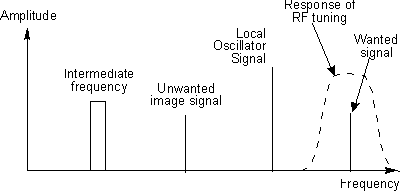Radio receiver image response and image rejection
- an overview or tutorial of the basics of superhet receiver image response
and image rejection as well as IF breakthrough specifications and their impact
on radio communications systems.
The superhet radio receiver is one of the most widely used
types of receiver available, being used in a wide variety of radio
communications applications from broadcast reception to advanced two way radio
communications systems, and fixed and mobile radio applications. One of the
important specifications associated with the operation of the superheterodyne
radio is its image response or image rejection. Along with this the IF
breakthrough is also of importance, although less critical in many applications.
However these specifications and parameters of radio receiver performance are of
great importance in radios used in all forms of radio communications
applications.
What is image response?
The basic concept of the superhet radio means that it is
possible for two signals to enter the intermediate frequency (IF) amplifier. For
example with the local oscillator set to 5 MHz and with an IF of 1 MHz it can be
seen that a signal at 6 MHz mixes with the local oscillator to produce a signal
at 1 MHz that will pass through the IF filter. However if a signal at 4 MHz is
also able to produce an output at 1 MHz. It is clearly unacceptable to receive
signals on two frequencies at the same time and it is possible to remove the
unwanted one by the addition of a tuned circuit prior to the mixer
Fortunately this tuned circuit does not need to be
excessively sharp. It does not need to reject signals on adjacent channels, but
instead it needs to reject signals on the image frequency. These will be
separated from the wanted channel by a frequency equal to twice the IF. In other
words with an IF at 1 MHz, the image will be 2 MHz away from the wanted
frequency.

Using a tuned circuit to remove the image signal
Effect of poor image rejection
A receiver with a poor level of image rejection will suffer
from much higher levels of interference than one with a high level of image
rejection. In view of this, radio receivers to be used in high performance radio
communications applications need to have a good image rejection performance.
When a radio receiver has a poor level image rejection
signals which should not be received as they are on the image will pass through
the IF stages along with the required ones. This means that unwanted signals are
received along with the wanted ones and this means that the levels of
interference will be higher than those with a high level of image rejection.
In addition to this the image signals will "tune" in the
opposite direction to the wanted ones. When they interfere heterodyne notes will
be heard and as the receiver is tuned, the pitch of the signals will change. In
view of this it is very important to reduce the image response to acceptable
levels, particularly for exacting radio communications applications.
Image rejection
It is clearly important to specify the level of image
rejection. The specification compares the levels of signals of equal strength on
the wanted and image frequencies, quoting the level of rejection of the unwanted
signal.
The image rejection of a receiver will be specified as the
ratio between the wanted and image signals expressed in decibels (dB)at a
certain operating frequency. For example it may be 60 dB at 30 MHz. This means
that if signals of the same strength were present on the wanted frequency and
the image frequency, then the image signal would be 60 dB lower than the wanted
one, i.e. it would be 1/1000 lower in terms of voltage or 1/1000000 lower in
terms of power.
The frequency at which the measurement is made also has to be
included. This is because the level of rejection will vary according to the
frequency in use. Typically it falls with increasing frequency because the
percentage frequency difference between the wanted and image signals is smaller.
IF Breakthrough
Another problem which can occur with a superhet occurs when
signals from the antenna break through the RF sections of the set and directly
enter the IF stages of the radio receiver. Normally intermediate frequencies are
chosen so that there are likely to be no very large signals present which might
cause problems. However when the radio receiver has a fixed frequency first
local oscillator this is not easy to ensure as it will sweep over a band of
frequencies.
The specification for breakthrough is quoted in the same
fashion as image rejection. Normally it is possible to achieve figures of 60 to
80 dB rejection, and on some receivers figures of 100 dB have been quoted.
Summary
The image response or image rejection and IF breakthrough
specifications of a superheterodyne radio are of great importance in many radio
communications applications. Any receiver with a poor image rejection
specification will appear to receive many more signals than one with a high
level of image rejection. As many of these signals will result from the poor
image rejection, they are not on the actual frequency to which the receiver is
tuned.
|

